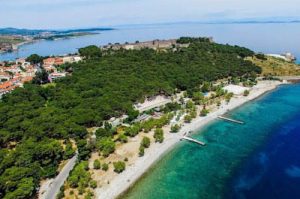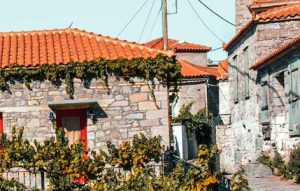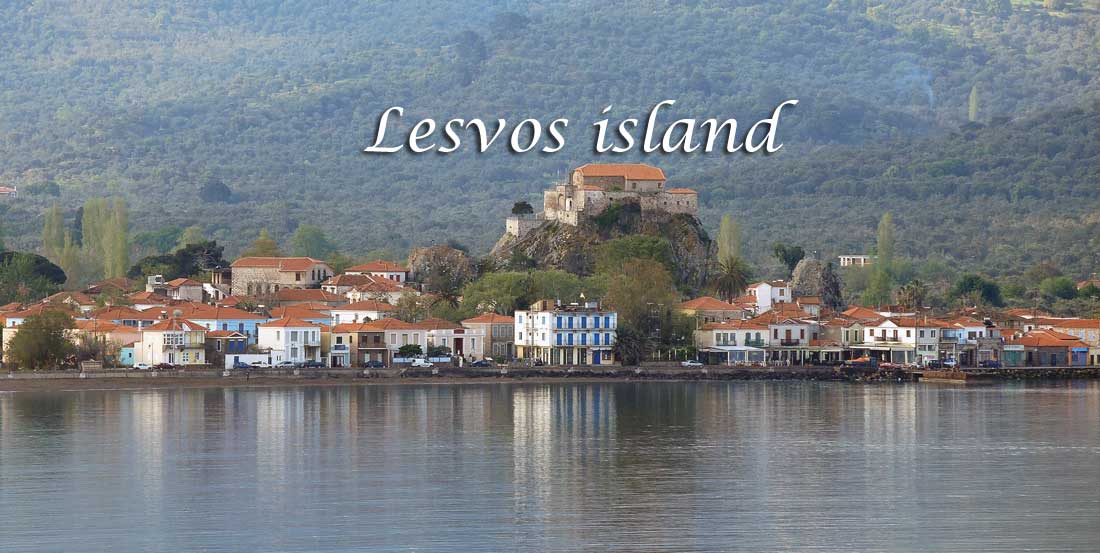
There, in the northwestern part of the island, among lush vegetation with pines, plane trees and olives, the traditional settlement of Sykamia stands out from afar with its stately, stone-built houses, the captivating view of the Aegean and the elegant cobblestone streets.
The people of Sykamia and its Skala are hospitable, kind and charming, they make the stay in their place even more pleasant with their discreet presence. Almost all of them have relatives abroad, mainly in Australia and America; the island once strongly fueled the immigration wave. Many expats return here for their holidays. You want the beauty of nature, you want the tranquility of the people, you want the greengrocer passing by with his van and proclaiming his goods, it’s a bit like going back to other times.
The Folklore Museum of Sykamia, a little below the Myrivili house, which is not open to visitors, and the three-aisled basilica church of Agia Fotini are also very beautiful, organized and interesting. In the museum, which is housed in the stone building of the primary school of the village, there is also a room with the personal belongings of Stratis Myrivilis.
Descending towards the sea, the observant eye of the visitor can see the terraces made of dry stones that the Skamniotes had built to rest on the way up, the “seats” as they called them. Shortly before arriving at Skala, as they call the ports of the mountain villages on the island, he faces a round of olive groves, which together with fishing are a main source of income for the island’s permanent residents.
Skala of Sykamia, a small fishing village, has such an aura and natural beauty that it is an ideal destination for those who want a quiet, relaxing holiday close to nature. And whoever finds himself there will hardly want to leave.
The trademark of the village is Panagia the Mermaid, the chapel that stands on the big rock in front of the little harbor with fishing boats, trawlers and trawlers. The old people call this rock “Tis Panagia ta rachta”. As Myrivilis says again, “…you climb the ridges, take a walk and look around, land and sea, and your eyes tear up. A joy drips from the trees, gushes from the brown and red soils, from the stones and the waters”*. This is the feeling one gets in Scala: that worries and problems can wait, they have no place in this relaxation and peace.
The chapel takes its name from the characteristic fresco by an unknown folk painter depicting the Virgin Mary with a mermaid’s tail, but it no longer exists in the church. In the summer, many christenings and weddings take place there, sometimes the brides like to come on a fishing boat. But all the functions in Panagia Gorgona acquire another grace, as they leave the small chapel and open to the port and the whole village. As for the sunset from the ridges overlooking the Aegean, it is certainly captivating. From the large rock of Panagia grows and spreads a wild fig tree that resists moisture and does not wither.

Before the Asia Minor Catastrophe, only those Skamnians who were fishermen and had small shops down there lived in Skala, as well as some Turks. When the refugees came and there was an exchange of populations, some of these houses were inhabited by the newcomers. Most, however, lived in shacks. Thus, the Synoikismos was then built, a little further from the square, following the coastal road towards the beach of Skala. Going towards Synoikismus, on the coastal road, you will find the unique mansion of Skala, surrounded by its large courtyard and high railings like an impregnable castle.
Beaches
The beach of Skala, Platanos, as the locals call it, is one of the two nearby options for swimming. Lesbos is known for its crystal clear, crystal clear seas, especially in the North. Skala Sykamias, in fact, is the northernmost settlement of the island. Which way the wind blows, the fishermen know how to tell you if the sea will be cold or not and if the currents that pass between the island and the Turkish coast so close will come towards our land. Platanos is just outside the Settlement, on the old dirt road that goes to Molyvos, along it there is plenty of shade from the big tamarisk trees and a row of benches and showers.
At the other end of the village, about 1.5 kilometers from the square of Skala, is the beach of Kaya with sand and small pebbles, also plenty of shade from the tamarisk trees, showers, changing rooms and two very nice tavernas with fresh fish dishes and other delicacies. You can also go to Kaya from the coastal path, a bit rough, that starts next to the port, where some fishermen are still mending their nets after fishing. And if you love fishing, you will find here an ideal place, and people very willing to help you.
How to get there
You can reach the city of Mytilini either by air or by ferry. From there, if you have your own means of transport, it will take you about an hour to reach Sykamia, which is 48 km from Mytilini. Alternatively, you can take a taxi which will cost you around 50 euros or the KTEL bus, which makes other stops, costs 5.40 euros (www.ktel-lesvou.gr/) and takes about an hour and a half. Skala of Sykamia is located at a distance of 2.5 km from Sykamia and the intercity bus also passes from there.
Where to stay
The area does not belong to the developed tourist resorts of Lesvos and therefore preserves its authenticity even more. However, it has the appropriate infrastructure for a comfortable stay.
